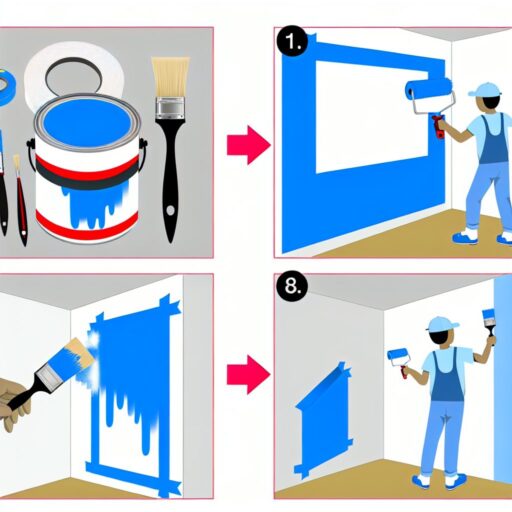How to Paint a Room
Painting a room is one of the easiest and most affordable home improvements you can make. It can completely change how a space looks and feels. Whether you want to brighten up your bedroom or give your living room a fresh look, painting is a great choice. You don’t need to be a professional to do it either! With the right tools and steps, anyone can paint a room like a pro. Let’s learn how to do it step by step.

Gather All Supplies Before You Begin


Before you start painting, you need to gather everything you’ll need. Having all the supplies ready saves time and keeps the process smooth. Here’s what you’ll need:
- Paint (choose your color and finish)
- Paint rollers and brushes
- Painter’s tape
- Drop cloths or plastic sheets
- Paint tray
- Sandpaper
- Primer (if needed)
- A ladder
- Cleaning rags
Pick the right type of paint for your project. For example, glossy paints are good for kitchens because they’re easy to clean. Matte paints work well in bedrooms for a softer look. Don’t forget to measure your walls to know how much paint to buy. A gallon usually covers about 350 square feet.
Use painter’s tape to mark off areas like windows, doors, and baseboards. This helps keep your lines neat. Place drop cloths on the floor to protect it from spills. Being prepared makes painting easier and less messy.
Having high-quality tools also matters. Cheap brushes may leave streaks or bristles behind. Invest in good equipment for better results. If you’re unsure about something, ask for advice at your local hardware store.
Once you have everything, set up your workspace. Make sure the room is well-lit so you can see what you’re doing. Open windows for ventilation if possible. Now you’re ready to start!
Prepare the Room for Painting

Preparation is key to a successful paint job. Start by cleaning the walls. Use a damp cloth to remove dirt, dust, and grease. Clean walls help the paint stick better. If there are any holes or cracks, fill them with spackle. Let the spackle dry, then sand it smooth.
Next, remove furniture from the room if you can. If that’s not possible, move it to the center and cover it with plastic sheets. This prevents accidental paint splatters. Take down wall decorations, such as picture frames and clocks.
Turn off power to electrical outlets and light switches. Remove their covers and tape over them. This keeps them free of paint and safe while you work. Also, check for any nails or screws in the walls and take them out.
If the walls are glossy or very dark, use sandpaper to lightly roughen the surface. This helps the new paint stick better. For darker colors, using a primer first is a good idea. Primer creates an even base for the paint and can save you from needing extra coats later.
Finally, apply painter’s tape along edges, corners, and trim. Press the tape firmly to prevent paint from seeping underneath. Double-check your setup before moving on. A well-prepared room makes painting much easier.
Choose the Right Paint Color

Picking the perfect color can feel overwhelming, but it’s also exciting. Think about the mood you want for the room. Warm colors like red and yellow make spaces feel cozy. Cool tones like blue and green create a calming effect. Neutral shades like gray and beige are versatile and timeless.
If you’re unsure, test a few samples. Paint small patches on the wall and observe them at different times of the day. Lighting can change how a color looks. Natural light shows true colors, while artificial light can make them appear warmer or cooler.
Also, consider the size of the room. Lighter colors make small spaces feel bigger, while darker shades create a more intimate vibe. For example, pale blue works well in a tiny bathroom, while deep navy adds drama to a large dining room.
Think about the existing décor too. Your paint should complement the furniture, rugs, and curtains. For instance, if you have colorful furniture, a neutral wall color balances the space. On the other hand, bold wall colors can make simple furniture pop.
Don’t rush this step. Take your time to choose a color you’ll love for years. Remember, paint is an affordable home improvement, so you can always repaint later if needed!
Learn the Proper Painting Technique

Now it’s time to start painting! Begin with the edges using a brush. Dip the brush into the paint, but don’t overload it. Wipe off excess paint to avoid drips. Carefully paint along the edges of the walls, around windows, and near the ceiling.
Once the edges are done, switch to a roller for larger areas. Pour paint into a tray and dip the roller into it. Roll off extra paint on the tray’s ridges. Start painting in a “W” pattern. This ensures even coverage and avoids streaks. Work in small sections, blending as you go.
Apply thin, even coats. Thick layers take longer to dry and may peel later. Allow each coat to dry fully before adding another. Follow the drying time recommended on the paint can. Usually, it takes 2-4 hours.
If you’re painting a ceiling, use a roller with an extension handle. This makes it easier to reach high spots. Always wear safety goggles to protect your eyes from paint splashes.
Take breaks when needed, but don’t let the paint sit too long. Keep your tools covered to prevent them from drying out. With patience and practice, you’ll achieve a flawless finish.
Clean Up After Painting

When you’re done painting, it’s time to clean up. Start by removing the painter’s tape. Do this slowly while the paint is still slightly wet. Pull the tape at a 45-degree angle for the best results.
Wash your brushes and rollers immediately. Use warm, soapy water for latex paints. For oil-based paints, you’ll need paint thinner or mineral spirits. Rinse thoroughly until the water runs clear.
Dispose of leftover paint responsibly. Don’t pour it down the drain. Check your local waste disposal guidelines for proper methods. You can also save extra paint for touch-ups later. Store it in a cool, dry place with the lid tightly sealed.
Fold up the drop cloths and remove them carefully. Be mindful of any wet paint to avoid smudges. Put back the furniture and decorations once the walls are completely dry. This usually takes about 24 hours.
Finally, admire your hard work! A freshly painted room can make your home feel brand new. Plus, you’ve gained a valuable skill you can use again in the future.
Tips for Avoiding Common Painting Mistakes

Even experienced painters make mistakes sometimes. Here are some tips to avoid common problems:
- Don’t skip the primer if you’re painting over a dark color.
- Always stir the paint before using it to mix the pigments evenly.
- Use enough paint on your roller to avoid patchy areas.
- Work in good lighting to catch imperfections early.
- Keep pets and kids out of the room while painting.
Another mistake is rushing. Take your time to prep, paint, and let each coat dry. Skipping steps can lead to uneven finishes or peeling paint. Also, don’t ignore weather conditions. High humidity can slow drying times, while extreme heat can cause cracking.
Learning from these tips will help you improve with every project. Practice makes perfect!
Benefits of Painting a Room Yourself

Painting a room yourself has many benefits. First, it saves money. Hiring professionals can be expensive, but doing it yourself is budget-friendly. This makes it one of the best affordable home improvements.
Second, it gives you control. You get to pick the colors, techniques, and finishing touches. It’s a chance to express your creativity and make the space truly yours.
Third, it’s satisfying. Completing a DIY project gives you a sense of accomplishment. You’ll enjoy the room even more knowing you did it yourself.
Lastly, it’s a fun activity to share with family or friends. Invite someone to help, and turn it into a bonding experience. Just make sure everyone wears old clothes!
Whether it’s your first time or you’re a seasoned painter, the rewards are worth the effort. A little paint can go a long way in transforming your home.
Final Thoughts: Transform Your Space with Paint

Painting a room might seem like a big task, but it’s manageable if you follow the right steps. Start by gathering supplies, preparing the room, and choosing the perfect color. Use proper techniques to apply the paint, and take your time to avoid mistakes. Once you’re done, clean up and enjoy your refreshed space.
This simple project is a fantastic way to improve your home without spending a lot of money. It’s a skill you can use again and again to keep your living spaces looking great. So grab your brushes and get started—your perfect room is just a coat of paint away!
